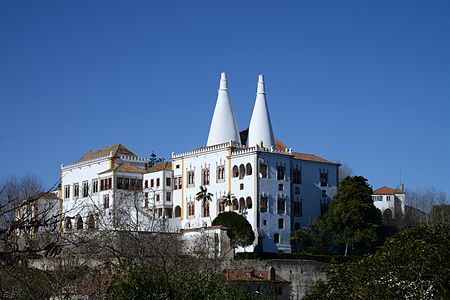Sintra National Palace
Azulejos in buildings in PortugalBuildings and structures in SintraGothic architecture in PortugalHistoric house museums in PortugalHouses completed in 1530 ... and 8 more
Manueline architectureMoorish architecture in PortugalMudéjar architectureMuseums in Lisbon DistrictNational monuments in Lisbon DistrictPalaces in Lisbon DistrictPalaces in PortugalRoyal residences in Portugal

The Palace of Sintra (Portuguese: Palácio Nacional de Sintra), also called Town Palace (Palácio da Vila), is located in the town of Sintra, in the Lisbon District of Portugal. It is a present-day historic house museum. It is the best-preserved medieval royal residence in Portugal, being inhabited more or less continuously from at least the early 15th century to the late 19th century. It is a significant tourist attraction, and is part of the cultural landscape of Sintra, a designated UNESCO World Heritage Site.
Excerpt from the Wikipedia article Sintra National Palace (License: CC BY-SA 3.0, Authors, Images).Sintra National Palace
Terreiro da Rainha Dona Amélia, Sintra (Santa Maria e São Miguel, São Martinho e São Pedro de Penaferrim)
Geographical coordinates (GPS) Address External links Nearby Places Show on map
Geographical coordinates (GPS)
| Latitude | Longitude |
|---|---|
| N 38.797777777778 ° | E -9.3908333333333 ° |
Address
Palácio Nacional de Sintra (Palácio da Vila)
Terreiro da Rainha Dona Amélia
2710-061 Sintra (Santa Maria e São Miguel, São Martinho e São Pedro de Penaferrim)
Portugal
Open on Google Maps








